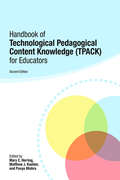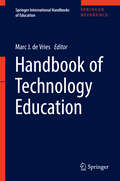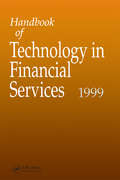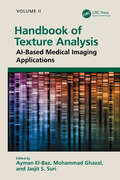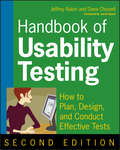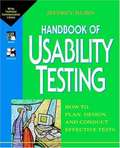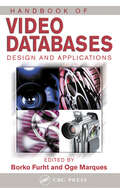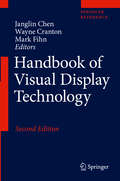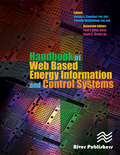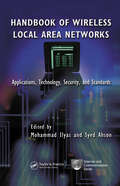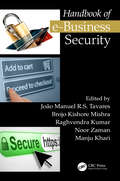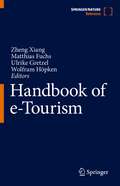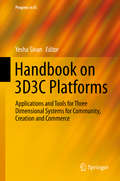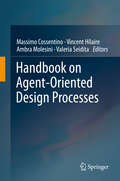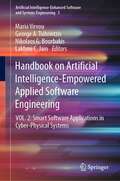- Table View
- List View
Handbook of Systems Thinking Methods
by Jason Thompson Neville A. Stanton Guy H. Walker Paul M. Salmon Natassia Goode Adam Hulme Gemma J.M. ReadThe systems thinking philosophy has become popular in human factors and ergonomics and safety science. These methods are being used to understand and resolve complex societal problems in areas such as transport safety, workplace safety, medication error, disaster management, child abuse, financial crises, terrorism, climate change and public health and wellbeing. This handbook presents practical step-by-step guidance for practitioners and researchers wishing to use these methods to tackle complex problems. Each method includes an example case study which demonstrates how the method can be applied and how the results can be interpreted and translated into practical recommendations. The book presents practical guidance on state-of-the-art systems thinking methods and offers case study applications describing systems thinking methods in novel areas. It explains how to translate the outputs of systems thinking methods in practice and introduces systems thinking with an overview of Human Factors and Ergonomics applications. This book will serve as a great reference for students and engineers in the field of systems engineering, complex systems and the design and development of systems, including ergonomics/human factors and systems engineers, designers, architects, industrial engineers, project management engineers, reliability engineers, risk engineers, software engineers and computer engineers.
Handbook of Technological Pedagogical Content Knowledge (TPACK) for Educators
by Mary C. Herring, Matthew J. Koehler and Punya MishraThe 2nd edition of the Handbook of Technological Pedagogical Content Knowledge (TPACK) for Educators addresses the concept and implementation of technological pedagogical content knowledge—the knowledge and skills that teachers need in order to integrate technology meaningfully into instruction in specific content areas. Driven by the growing influence of TPACK on research and practice in both K-12 and higher education, the 2nd edition updates current thinking about theory, research, and practice. Offering a series of chapters by scholars in different content areas who apply the technological pedagogical content knowledge framework to their individual content areas, the volume is structured around three themes: Current thoughts on TPACK Theory Research on Technological Pedagogical Content Knowledge in Specific Subject Areas Integrating Technological Pedagogical Content Knowledge into Teacher Education and Professional Development The Handbook of Technological Pedagogical Content Knowledge (TPACK) for Educators is simultaneously a mandate and a manifesto on the engagement of technology in classrooms.
Handbook of Technology Education
by Marc J. de VriesThis handbook of technology education offers a state-of-the-art survey of developments in technology education worldwide. It deals with general themes like philosophical foundations, curriculum, teaching and learning, teacher education, and educational technology. It also has some technology-specific topics, such as designing, making, and assessment (portfolios). To focus on the specific learning challenges a separate section of the book is dedicated to sub-domains of technology and engineering, like food, textiles, materials and robotics. Explicit attention is given to the possible role of technology (and engineering) education in Science, Technology, Engineering and Mathematics (STEM) education. Recent developments such as technology concept learning, authentic learning, pre-university engineering education, design-based learning and design-based research for technology education, pedagogical content knowledge for technology educators, and the use of e-portfoli os are included. One section deals with social and cultural issues, such as education for sustainability, gender issues in technology education, indigenous technologies, industry involvement and the relation between technology education and communication. As could be expected in a handbook on technology education, there is also a section on the use of technology for teaching about technology: the use of CAD, science fiction movies, animations, internet and social media. All chapters are written especially for this handbook by a selection of authors, some of whom have been part of the history of technology education for many years, some of whom are promising young researchers. The book can be used as a reference by technology education researchers to get a concise introduction into the field. It can also be used as a resource in technology teacher education programs. Technology teachers can use it as literature for deepening their understanding of the field and thus working on their continuous professionalization. Curriculum developers and policy makers will find it of interest to get an understanding for the need to have technology education in the curriculum and the way it can be realized in practice.
Handbook of Technology in Financial Services
by Jessica KeyesThe calculus of IT support for the banking, securities and insurance industries has changed dramatically and rapidly over the past few years. Unheard of just a few years ago, corporate intranets are now used for everything from job postings to enhanced team communications. Whole new departments are being created to support e-commerce. And the Internet/Intranet/Extranet triple-whammy is the most critical component of most financial IT shops. At the same time, intelligent agents stand ready to take on such diverse functions as customer profiling and data mining.
Handbook of Terrorist and Insurgent Groups: A Global Survey of Threats, Tactics, and Characteristics
by Animesh Roul Scott N. Romaniuk János Besenyő Amparo Pamela FabeHandbook of Terrorist and Insurgent Groups: A Global Survey of Threats, Tactics, and Characteristics examines the most current and significant terrorist and insurgent groups around the world. The purpose is to create a descriptive mosaic of what is a pointedly global security challenge.The volume brings together conceptual approaches to terrorism, insurgency, and cyberterrorism with substantive and empirical analyses of individual groups, organisations, and networks. By doing so, not only does the coverage highlight the past, present, and future orientations of the most prominent groups, but it also examines and illustrates their key characteristics and how they operate, including key leaders and ideologues. Highlighting specific, individual groups, the chapters collectively present a robust and comprehensive outlook on the current geography of terrorism and insurgency groups operating in the world today.This comprehensive volume brings the collective expertise and knowledge of more than 50 academics, intelligence and security officials, and professionals together, all of whom are considered subject experts in their respective areas of research and practice. The volume is based on both desk-based and fieldwork conducted by experts in these areas, incorporating analyses of secondary literature but also the use of primary data including first-hand interviews on the various groups’ regions of operation, their tactics, and how their ideologies motivate their actions.
Handbook of Texture Analysis: AI-Based Medical Imaging Applications
by Jasjit S. Suri Ayman El-Baz Mohammed GhazalThe major goals of texture research in computer vision are to understand, model, and process texture and, ultimately, to simulate the human visual learning process using computer technologies. In the last decade, artificial intelligence has been revolutionized by machine learning and big data approaches, outperforming human prediction on a wide range of problems. In particular, deep learning convolutional neural networks (CNNs) are particularly well suited to texture analysis. This volume presents important branches of texture analysis methods which find a proper application in AI-based medical image analysis. This book: Discusses first-order, second-order statistical methods, local binary pattern (LBP) methods, and filter bank-based methods Covers spatial frequency-based methods, Fourier analysis, Markov random fields, Gabor filters, and Hough transformation Describes advanced textural methods based on DL as well as BD and advanced applications of texture to medial image segmentation Is aimed at researchers, academics, and advanced students in biomedical engineering, image analysis, cognitive science, and computer science and engineering This is an essential reference for those looking to advance their understanding in this applied and emergent field.
Handbook of Texture Analysis: Generalized Texture for AI-Based Industrial Applications
by Jasjit S. Suri Ayman El-Baz Mohammed GhazalThe major goals of texture research in computer vision are to understand, model, and process texture, and ultimately, to simulate the human visual learning process using computer technologies. In the last decade, artificial intelligence has been revolutionized by machine learning and big data approaches, outperforming human prediction on a wide range of problems. In particular, deep learning convolutional neural networks (CNNs) are particularly well suited to texture analysis. This book examines four major application domains related to texture analysis and their relationship to AI-based industrial applications: texture classification, texture segmentation, shape from texture, and texture synthesis. This volume: Discusses texture-based segmentation for extracting image shape features, modeling and segmentation of noisy and textured images, spatially constrained color-texture model for image segmentation, and texture segmentation using Gabor filters Examines textural features for image classification, a statistical approach for classification, texture classification from random features, and applications of texture classifications Describes shape from texture, including general principles, 3D shapes, and equations for recovering shape from texture Surveys texture modeling, including extraction based on Hough transformation and cycle detection, image quilting, gray level run lengths, and use of Markov random fields Aimed at researchers, academics, and advanced students in biomedical engineering, image analysis, cognitive science, and computer science and engineering, this is an essential reference for those looking to advance their understanding in this applied and emergent field.
Handbook of Trustworthy Federated Learning (Springer Optimization and Its Applications #213)
by My T. Thai Bhavani Thuraisingham Hai N. PhanThis handbook aims to serve as a one-stop, reliable resource, including curated surveys and expository contributions on federated learning. It covers a comprehensive range of topics, providing the reader with technical and non-technical fundamentals, applications, and extensive details of various topics. The readership spans from researchers and academics to practitioners who are deeply engaged or are starting to venture into the realms of trustworthy federated learning. First introduced in 2016, federated learning allows devices to collaboratively learn a shared model while keeping raw data localized, thus promising to protect data privacy. Since its introduction, federated learning has undergone several evolutions. Most importantly, its evolution is in response to the growing recognition that its promise of collaborative learning is inseparable from the imperatives of privacy preservation and model security. The resource is divided into four parts. Part 1 (Security and Privacy) explores the robust defense mechanisms against targeted attacks and addresses fairness concerns, providing a multifaceted foundation for securing Federated Learning systems against evolving threats. Part 2 (Bilevel Optimization) unravels the intricacies of optimizing performance in federated settings. Part 3 (Graph and Large Language Models) addresses the challenges in training Graph Neural Networks and ensuring privacy in Federated Learning of natural language models. Part 4 (Edge Intelligence and Applications) demonstrates how Federated Learning can empower mobile applications and preserve privacy with synthetic data.
Handbook of Usability Testing
by Jeffrey Rubin Jared Spool Dana ChisnellWhether it?s software, a cell phone, or a refrigerator, your customer wants?no, expects?your product to be easy to use. This fully revised handbook provides clear, step-by-step guidelines to help you test your product for usability. Completely updated with current industry best practices, it can give you that all-important marketplace advantage: products that perform the way users expect. You?ll learn to recognize factors that limit usability, decide where testing should occur, set up a test plan to assess goals for your product?s usability, and more.
Handbook of Usability Testing: How to Plan, Design, and Conduct Effective Tests
by Jeffrey RubinDescribes everything needed for businesses to set up and begin conducting usability tests.
Handbook of Variational Methods for Nonlinear Geometric Data
by Philipp Grohs Martin Holler Andreas WeinmannThis book covers different, current research directions in the context of variational methods for non-linear geometric data. Each chapter is authored by leading experts in the respective discipline and provides an introduction, an overview and a description of the current state of the art. Non-linear geometric data arises in various applications in science and engineering. Examples of nonlinear data spaces are diverse and include, for instance, nonlinear spaces of matrices, spaces of curves, shapes as well as manifolds of probability measures. Applications can be found in biology, medicine, product engineering, geography and computer vision for instance. Variational methods on the other hand have evolved to being amongst the most powerful tools for applied mathematics. They involve techniques from various branches of mathematics such as statistics, modeling, optimization, numerical mathematics and analysis. The vast majority of research on variational methods, however, is focused on data in linear spaces. Variational methods for non-linear data is currently an emerging research topic. As a result, and since such methods involve various branches of mathematics, there is a plethora of different, recent approaches dealing with different aspects of variational methods for nonlinear geometric data. Research results are rather scattered and appear in journals of different mathematical communities. The main purpose of the book is to account for that by providing, for the first time, a comprehensive collection of different research directions and existing approaches in this context. It is organized in a way that leading researchers from the different fields provide an introductory overview of recent research directions in their respective discipline. As such, the book is a unique reference work for both newcomers in the field of variational methods for non-linear geometric data, as well as for established experts that aim at to exploit new research directions or collaborations.Chapter 9 of this book is available open access under a CC BY 4.0 license at link.springer.com.
Handbook of Vascular Biometrics (Advances in Computer Vision and Pattern Recognition)
by Sébastien Marcel Andreas Uhl Christoph Busch Raymond VeldhuisThis open access handbook provides the first comprehensive overview of biometrics exploiting the shape of human blood vessels for biometric recognition, i.e. vascular biometrics, including finger vein recognition, hand/palm vein recognition, retina recognition, and sclera recognition. After an introductory chapter summarizing the state of the art in and availability of commercial systems and open datasets/open source software, individual chapters focus on specific aspects of one of the biometric modalities, including questions of usability, security, and privacy. The book features contributions from both academia and major industrial manufacturers.
Handbook of Video Databases: Design and Applications (Internet and Communications)
by Borko Furht Oge MarquesTechnology has spurred the growth of huge image and video libraries, many growing into the hundreds of terabytes. As a result there is a great demand among organizations for the design of databases that can effectively support the storage, search, retrieval, and transmission of video data. Engineers and researchers in the field demand a comprehensi
Handbook of Virtual Environments: Design, Implementation, and Applications, Second Edition (Human Factors and Ergonomics)
by Kelly S. Hale Kay M. StanneyA Complete Toolbox of Theories and TechniquesThe second edition of a bestseller, Handbook of Virtual Environments: Design, Implementation, and Applications presents systematic and extensive coverage of the primary areas of research and development within VE technology. It brings together a comprehensive set of contributed articles that address the
Handbook of Visual Display Technology
by Janglin Chen Wayne Cranton Mark FihnThis handbook offers a comprehensive description of the science, technology, economic and human interface factors associated with the displays industry. With expert contributions from over 150 international display professionals and academic researchers, it covers all classes of display device and discusses established principles, emergent technologies, and particular areas of application.
Handbook of Visual Display Technology
by Janglin Chen Wayne Cranton Mark FihnThe second Edition of this remarkable Handbook offers readers a comprehensive overview of the science and technology of visual displays and the economic and human interface factors associated with the displays industry. Unique in the displays field, the Handbook serves as a single reference source with expert contributions from over 150 international display professionals and academic researchers. The Handbook contains extensive coverage of established and emerging display technologies, with discussion of physical principles, materials science and processing, device technologies and particular areas of application. The wide-ranging content also encompasses the fundamental science of light and vision, image acquisition and manipulation, display materials and processing techniques, TFTs, display driving and metrology. Prominence is given to liquid crystal displays, with later chapters devoted to emerging technologies including flexible displays, electrophoretic, electrowetting and electrofluidic displays and MEMS-based displays. Other sections consider 3D display solutions, projection systems and head-worn displays. Updated and extended throughout, major changes in the 2nd Edition include: * Significantly expanded section on touch and human-computer interaction * Reworked and updated chapters on OLEDs * Revised and extended coverage of mobile display technologies ". . . no engineering or science library can be without this book. It will be an asset for all companies engaged in display and display-related business. " - extract from the Foreword of the 1st Edition by Dr M Anandan, President, Society for Information Display.
Handbook of Web Based Energy Information and Control Systems
by Barney L. Capehart Timothy MiddelkoopThis book promotes the benefits of the development and application of energy information and control systems. This wave of information technology (IT) and web-based energy information and control systems (web based EIS/ECS) continues to roll on with increasing speed and intensity. This handbook presents recent technological advancements in the field, as well as a compilation of the best information from three previous books in this area. The combined thrust of this information is that the highest level functions of the building and facility automation system are delivered by a web based EIS/ECS system that provides energy management, facility management, overall facility operational management and ties in with the enterprise resource management system for the entire facility or the group of facilities being managed.
Handbook of Wireless Local Area Networks: Applications, Technology, Security, and Standards (Internet and Communications)
by Mohammad Ilyas Syed AhsonConsisting of 25 articles contributed by expert authors from around the world, this handbook begins with a detailed introduction that provides an overview of LAN technologies, performance, security, and security protocols. It then delves further into WLAN technology, covering space-time processing, WLAN and cellular convergence, and a peer-to-peer approach to roaming, along with other topics. The Handbook continues by exploring WLAN applications, followed by an extensive discussion of security that includes the steps that can be taken to minimize WLAN security risks. This text concludes with an analysis of standards, describing 3G UMTS - IEEE 802.11b internetworking and security.
Handbook of e-Business Security
by Raghvendra Kumar João Manuel Tavares Manju Khari Brojo Kishore Mishra Noor ZamanThere are a lot of e-business security concerns. Knowing about e-business security issues will likely help overcome them. Keep in mind, companies that have control over their e-business are likely to prosper most. In other words, setting up and maintaining a secure e-business is essential and important to business growth. This book covers state-of-the art practices in e-business security, including privacy, trust, security of transactions, big data, cloud computing, social network, and distributed systems.
Handbook of e-Tourism
by Ulrike Gretzel Zheng Xiang Matthias Fuchs Wolfram HöpkenThis handbook provides an authoritative and truly comprehensive overview both of the diverse applications of information and communication technologies (ICTs) within the travel and tourism industry and of e-tourism as a field of scientific inquiry that has grown and matured beyond recognition. Leading experts from around the world describe cutting-edge ideas and developments, present key concepts and theories, and discuss the full range of research methods. The coverage accordingly encompasses everything from big data and analytics to psychology, user behavior, online marketing, supply chain and operations management, smart business networks, policy and regulatory issues – and much, much more. The goal is to provide an outstanding reference that summarizes and synthesizes current knowledge and establishes the theoretical and methodological foundations for further study of the role of ICTs in travel and tourism. The handbook will meet the needs of researchers and students in various disciplines as well as industry professionals. As with all volumes in Springer’s Major Reference Works program, readers will benefit from access to a continually updated online version.
Handbook of the Tutte Polynomial and Related Topics
by Joanna A. Ellis-Monaghan Iain MoffattThe Tutte Polynomial touches on nearly every area of combinatorics as well as many other fields, including statistical mechanics, coding theory, and DNA sequencing. It is one of the most studied graph polynomials. Handbook of the Tutte Polynomial and Related Topics is the first handbook published on the Tutte Polynomial. It consists of thirty-four chapters, written by experts in the field, that collectively offer a concise overview of the polynomial’s many properties and applications. Each chapter covers a different aspect of the Tutte polynomial, and contains the central results and references for its topic. The chapters are organized in six parts. Part I describes the fundamental properties of the Tutte polynomial, providing an overview of the Tutte polynomial and the necessary background for the rest of the handbook. Part II is concerned with questions of computation, complexity and approximation for the Tutte polynomial; Part III covers a selection of related graph polynomials; Part IV discusses a range of applications of the Tutte polynomial to mathematics, physics, and biology; Part V includes various extensions and generalizations of the Tutte polynomial; Part VI provides a history of the development of the Tutte polynomial. Features Written in an accessible style for non-experts yet extensive enough for experts. Serves as a comprehensive and accessible introduction to the theory of graph polynomials for researchers in mathematics, physics, and computer science. Provides an extensive reference volume for the evaluations, theorems, and properties of the Tutte polynomial and related graph, matroid, and knot invariants. Offers broad coverage, touching on the wide range of applications of the Tutte polynomial and its various specializations.
Handbook on 3D3C Platforms
by Yesha SivanThis book presents 3D3C platforms - three-dimensional systems for community, creation and commerce. It discusses tools including bots in social networks, team creativity, privacy, and virtual currencies & micropayments as well as their applications in areas like healthcare, energy, collaboration, and art. More than 20 authors from 10 countries share their experiences, research fi ndings and perspectives, off ering a comprehensive resource on the emerging fi eld of 3D3C worlds. The book is designed for both the novice and the expert as a way to unleash the emerging opportunities in 3D3C worlds. This Handbook maps with breadth and insight the exciting frontier of building virtual worlds with digital technologies. David Perkins, Research Professor, Harvard Graduate School of Education This book is from one of the most adventurous and energetic persons I have ever met. Yesha takes us into new undiscovered spaces and provides insight into phenomena of social interaction and immersive experiences that transform our lives. Cees de Bont, Dean of School of Design & Chair Professor of Design, School of Design of the Hong Kong Polytechnic University When you read 3D3C Platforms you realize what a domain like ours -- 3D printing -- can and should do for the world. Clearly we are just starting. Inspiring. David Reis, CEO, Stratasys Ltd This book provides a stunning overview regarding how virtual worlds are reshaping possibilities for identity and community. Th e range of topics addressed by the authors-- from privacy and taxation to fashion and health care--provide a powerful roadmap for addressing the emerging potential of these online environments. Tom Boellstorff , Professor, Department of Anthropology, University of California, Irvine Handbook on 3D3C Platforms amassed a unique collection of multidisciplinary academic thinking. A primer on innovations that will touch every aspect of the human community in the 21st century. Eli Talmor, Professor, London Business School
Handbook on Agent-Oriented Design Processes
by Massimo Cossentino Vincent Hilaire Ambra Molesini Valeria SeiditaTo deal with the flexible architectures and evolving functionalities of complex modern systems, the agent metaphor and agent-based computing are often the most appropriate software design approach. As a result, a broad range of special-purpose design processes has been developed in the last several years to tackle the challenges of these specific application domains. In this context, in early 2012 the IEEE-FIPA Design Process Documentation Template SC0097B was defined, which facilitates the representation of design processes and method fragments through the use of standardized templates, thus supporting the creation of easily sharable repositories and facilitating the composition of new design processes. Following this standardization approach, this book gathers the documentations of some of the best-known agent-oriented design processes. After an introductory section, describing the goal of the book and the existing IEEE FIPA standard for design process documentation, thirteen processes (including the widely known Open UP, the de facto standard in object-oriented software engineering) are documented by their original creators or other well-known scientists working in the field. As a result, this is the first work to adopt a standard, unified descriptive approach for documenting different processes, making it much easier to study the individual processes, to rigorously compare them, and to apply them in industrial projects. While there are a few books on the market describing the individual agent-oriented design processes, none of them presents all the processes, let alone in the same format. With this handbook, for the first time, researchers as well as professional software developers looking for an overview as well as for detailed and standardized descriptions of design processes will find a comprehensive presentation of the most important agent-oriented design processes, which will be an invaluable resource when developing solutions in various application areas.
Handbook on Artificial Intelligence-Empowered Applied Software Engineering: VOL.1: Novel Methodologies to Engineering Smart Software Systems (Artificial Intelligence-Enhanced Software and Systems Engineering #2)
by Lakhmi C. Jain Maria Virvou George A. Tsihrintzis Nikolaos G. BourbakisThis book provides a structured overview of artificial intelligence-empowered applied software engineering. Evolving technological advancements in big data, smartphone and mobile software applications, the Internet of Things and a vast range of application areas in all sorts of human activities and professions lead current research towards the efficient incorporation of artificial intelligence enhancements into software and the empowerment of software with artificial intelligence. This book at hand, devoted to Novel Methodologies to Engineering Smart Software Systems Novel Methodologies to Engineering Smart Software Systems, constitutes the first volume of a two-volume Handbook on Artificial Intelligence-empowered Applied Software Engineering. Topics include very significant advances in (i) Artificial Intelligence-Assisted Software Development and (ii) Software Engineering Tools to develop Artificial Intelligence Applications, as well as a detailed Survey of Recent Relevant Literature. Professors, researchers, scientists, engineers and students in artificial intelligence, software engineering and computer science-related disciplines are expected to benefit from it, along with interested readers from other disciplines.
Handbook on Artificial Intelligence-Empowered Applied Software Engineering: VOL.2: Smart Software Applications in Cyber-Physical Systems (Artificial Intelligence-Enhanced Software and Systems Engineering #3)
by Lakhmi C. Jain Maria Virvou George A. Tsihrintzis Nikolaos G. BourbakisEvolving technological advancements in big data, smartphone and mobile software applications, the Internet of Things and a vast range of application areas in all sorts of human activities and professions, lead current research toward the efficient incorporation of artificial intelligence enhancements into software and the empowerment of software with artificial intelligence. The book at hand, devoted to Smart Software Applications in Cyber-Physical Systems, constitutes the second volume of a two-volume Handbook on Artificial Intelligence-empowered Applied Software Engineering. Topics include very significant advances in Smart Software Applications in (i) Scientific Document Processing, (ii) Enterprise Modeling, (iii) Education, (iv) Health care and Medicine, and (v) Infrastructure Monitoring. Professors, researchers, scientists, engineers, and students in artificial intelligence, software engineering, and computer science-related disciplines are expected to benefit from it, along with interested readers from other disciplines.

